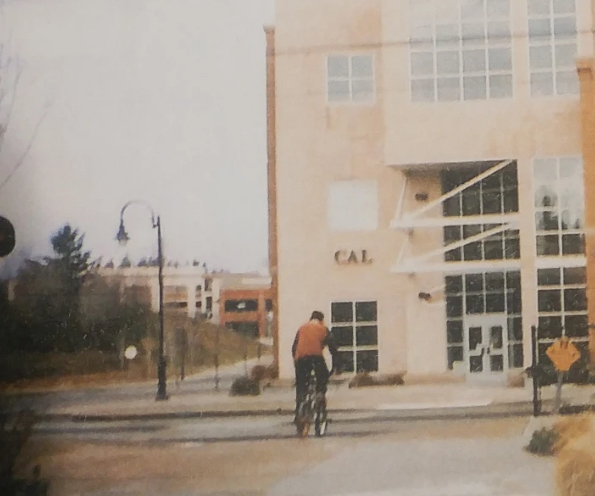
(Photo: Sturdy family)
Greg Spencer is a writer and editor who volunteers with the local chapter of Families for Safe Streets.
Eighty crosswalks and 45 light-rail stations made safer. That’s how Darla Sturdy sums up her proudest accomplishment to date.
Sturdy, a Gresham mother and member of Families for Safe Streets Oregon and SW Washington, never imagined a second life as a transportation engineer, much less as a lobbyist. But this is the work she threw herself into after her boy was run over and killed by a MAX light rail train.


Sturdy began collecting data on MAX’s safety record, finding 505 crashes (including 108 with people on foot or bikes) between 1994 and 2006.
The evening of June 23, 2003, Aaron Wagner-Sturdy, age 16, was heading home from a church youth group meeting on his bicycle. He pedaled westbound next to the MAX tracks at Gresham City Hall Station, and turned left to get across the tracks by using the pedestrian crossing. He meant to cross behind an eastbound train that was just pulling out. However, a second train going in the opposite direction was coming in at about 35 mph and Aaron didn’t spot it in time. The driver honked but it was too late. Aaron’s bike left a 6-8-foot skid mark, according to the police report.
For months after her son’s death, Sturdy was in a daze. She lost weight, and had to quit her job as general manager of the Spa Outlet. “I lost who I was,” Sturdy says. “It’s kind of like when you lose a child, you lose you, too. And your family loses you, because you went with him.”
In her grief, she started taking daily drives from her home, to the MAX station, to the cemetery where Aaron was buried — trying to make sense of it. At the MAX station, she watched trains coming in and out and saw several close calls with people crossing the tracks. It settled in her mind that the crossings were unsafe. “It took me about three years, but I finally realized why God put me here.”
Advertisement

Looking out for each other
Sturdy knew she could never bring back her own boy. But she could help other families avoid a similar fate. Having grown up in the small town of Milton-Freewater, Sturdy saw it as her duty. “In small towns, people look out for each other,” she said.
“Saving lives is number one to me and I want to make sure it is to them.”
— Darla Sturdy
TriMet laid the MAX lines in Gresham in the eighties, when the area was much less developed. Although a few newer MAX stations on Portland’s west side had gated crossings for walkers, most didn’t, certainly not the legacy stations in Gresham, and by then Gresham had grown into a bustling suburb with schools, homes and businesses right next to the tracks.
Sturdy began collecting data on MAX’s safety record, finding 505 crashes (including 108 with people on foot or bikes) between 1994 and 2006. She compiled photos of unsafe crossings, including one in Gresham that lied just 25 feet from a public school. TriMet’s own internal guidelines called for protective gates for crossings within 600 feet of schools.
Sturdy took her growing folder of evidence to the Oregon State Capitol and began working there every Wednesday and Friday, meeting 12 to 15 legislators each visit to get support for a bill she dubbed “Aaron’s Bridge to Safety.” All the while, she pulled full shifts at the Spa Outlet on weekends to fulfill her 40-hour work week.
It was no easy fight. After she’d collected the needed signatures in the House, the chairwoman of the transport committee refused to give the bill a hearing. So she introduced the bill in the Senate: wash, rinse, repeat. She got it through the Senate, and with that momentum she conquered the House, as well.
In 2007, the governor signed Senate Bill 829 into law, requiring TriMet to submit to an independent safety review of nearly 80 of its sidewalks. It took years of more lobbying– and the death of another person at the same Gresham City Hall crossing — but finally the study’s recommendations were put into force. TriMet started carrying out the improvements in 2009, and they were at last finished in 2017 — 45 stations and 80 sidewalks made safer thanks to the tireless efforts of one angry mother.
Taking it to Tigard
These days, Sturdy continues to attend occasional TriMet board meetings with David Sale, a fellow member of Families for Safe Streets who also lost a child in a public transit crash. Sturdy wants to build on her light-rail work, and ensure that the planned extension of the MAX to Tigard includes safe bike and foot crossings. “I’m trying to be part of that planning to make it safe in the beginning instead of years later,” Sturdy says. “Saving lives is number one to me and I want to make sure it is to them.”
— Greg Spencer
Never miss a story. Sign-up for the daily BP Headlines email.
BikePortland needs your support.





It seems that we don’t like these gates.
Despite objections, TriMet installs swing-gates at 11th Avenue rail crossing
https://bikeportland.org/2015/12/23/171072-171072
https://bikeportland.org/2016/01/28/new-video-shows-major-issue-with-trimets-new-swing-gates-173538
https://bikeportland.org/2015/07/16/trimet-wants-install-swing-gates-inner-southeast-max-crossings-150118
https://bikeportland.org/2016/02/02/activists-prop-open-trimet-swing-gates-along-orange-line-173943
https://bikeportland.org/2015/07/27/city-advisory-committees-oppose-trimets-plans-swing-gates-orange-line-151254
https://bikeportland.org/2015/09/29/trimet-adjusts-orange-line-crossing-plans-after-community-opposition-163836
I personally hate these gates. They’re just another obstruction burdening vulnerable users that people in motor vehicles don’t have to deal with. They’re like crosswalk beg-buttons to me.
They should be required to put fully automated crossing arms like are required at real train crossings of pedestrian paths.
Swing gates are different than crossing arms: the former is always closed, even when no train is within miles (making riding across the tracks difficult at all times); the latter only blocks passage when a train is actually coming.
That distinction is true and often overlooked by those who do not deal with them on a daily basis. Just imagine having to exit a car, open a gate, and then climb back into the vehicle to advance through an intersection daily on one’s commute and have to complete the manuever within 5 seconds per 1990 ADA guidelines on minimum standards. To walk a mile in another’s boots.. and the impediment to safe, efficient travel is glaringly obvious.
The law that Darla pushed through the legislature simply required TriMet to submit to an independent safety review of its MAX stations and foot crossings. And that review determined that every ped crossing on the MAX network at that time (2008) was inadequate from a safety point of view. Darla wasn’t advocating for any specific design solution. But she was — and still is — absolutely against having wide-open, barrier-free foot crossings.
Excellent story Greg and thanks for writing it. Darla Sturdy is an inspiration to all of us.
The “train just passed, but there’s another coming the other direction” trap is pernicious; this is a special problem by the Clinton St. Station where the signals are so jacked that people mostly ignore them. Several times a day, there is a Amtrak train racing through there at 60mph; that’s infrequently enough that many people rarely encounter it.
The bad behavior induced by the lack of signal sanity creates a dangerous situation. Please, *ALWAYS* look both ways when crossing any of those tracks when the gates are down, even if the Max has already passed.
Was at that crossing yesterday and people have certainly learned to make their own decisions about safe crossings. While we waited, and waited, the people in front realized that it was a freight train coming and biked in front of it with plenty of time to spare. We watched it go by, and it was just a few engines. We then crossed and waited at the next set of tracks. Sure enough, there was a MAX train approaching. Waited and waited again and we all decided that there were no more trains and we all crossed against the red flashing lights.
At a crossing near my home, Union Pacific uses the crossing and nearby switch as part of their rail yard for building trains. (I’m not sure they’re allowed to do that, but it’s what it is.) Over the past couple of weeks, they have begun dropping the crossing arms when the train is still two minutes away. I’ve noticed a substantial increase already in the number of people on bikes who decide to just cross. As this number increases, I expect to see a fatal mistake made where someone doesn’t look at all the tracks before proceeding when a train is coming.
Too bad grade separation is so expensive these days. However, even when you do have a bridge or tunnel/culvert, many pedestrians continue to try crossing wherever it’s convenient, as one can see from well-worn foot paths crossing the tracks in most cities. Here in Greensboro we get 1-2 pedestrian deaths annually from trains moving 50-60 mph, both Norfolk&Southern and AMTRAK. The only “cheap” solution is to built very high fences on both sides of the tracks, as they do in Europe, but the cost escalates in the USA when you realize how many buildings have (illegally) been built into the existing railroad right-of-way over the last 150 years, even in Portland.
Yes rail grade separation is expensive, but it was cheaper back in the day…many communities mandated these safety improvements back in the early 1900s…these Portland freight line crossings should have been dealt with back then.
They are now more critical than ever given the “mile” length of multi engine freight rail trains pulling oil/ coal through our communities.
There will be blood on TriMet’s hands when someone dies at the Clinton area crossing. That area is a horrible testament to design by group think. I curse it every time I pass through.
The whole thing should have been trenched when they built the Orange Line.
In Japan, they usually have lighted arrows beneath the signal lights to indicate which direction the trains are coming from. In the UK, they often put up signs that say, “If warning lights still show, there’s another train coming in the opposite direction.” The arrow style indicators would really help, and so would standard crossing gates.
I like the signs painted on the sidewalks in the UK at street and rail crossings: “Look Left” or “Look Right”.
That sounds lovely!
I saw that while I lived in Taiwan too, arms go down, and a sign blinking which direction it is coming from is seen. If a second train is coming the other direction sign will light up too. At certain crossings they post police officers during commute time to enforce not crossing.
This is when grade separated rail starts to look reasonably affordable.
Would love to have some examples of how gates were improved.
Hey Soren, I have before-after photos of one Gresham crossing where improvements were made. It’s across the street from a high school, the Center for Advanced Learning (CAL), 1484 NW Civic Drive, attended by 450 students. You can see that before the changes, it had a crossing gate for street traffic, but nothing at all for the pedestrian crossing.
Before(1): https://drive.google.com/file/d/1NPV3LEvRz6B-PXIs2aJ7Bbc0N_zMo8yv/view?usp=sharing
Before(2): https://drive.google.com/file/d/1LLqbYHnKd4BsXKCZLxavi1i7dGnQju7S/view?usp=sharing
After: https://drive.google.com/file/d/1emRGhidX6tm966dbjAV2vJpumO75Yb81/view?usp=sharing
So she is the one I can “thank” for having to go through a maze to cross the light rail?
What may seem nothing more than an inconvenience to you may be a lifesaver to someone else.
I only wish there was a way to alert people of a coming train without requiring everyone to open a gate at all times.
Maybe they could come up with some kind of visual or audio type of warning. Maybe a flashing light or a ringing bell. Or both, in case you can’t see or can’t hear.
That’s probably asking too much.
Although, to be serious for a moment, I completely ignore TriMet train horns and bells now thanks to their overuse of them when they’re not needed. I know not to cross tracks without looking because, you know, it’s a basic rule you learn growing up. We were lucky if there was anything more than a white wooden X of a sign to let us know to beware.
Greg, a typo: “…including one in Gresham that lied just 25 feet from a public school.”
Not “lied”, but “lay”.
“… including one in Gresham that IS just 25 feet from a public school.”
Well spotted, David.
Another issue around Max crossings: reduced visibility.
https://bikeportland.org/2016/03/29/gresham-police-say-10-year-old-boys-death-on-burnside-is-horrible-accident-179382
The pictures added to this article with before and after show that the bushes and trees have grown to somewhat obstruct visibility. Luckily the slight slalom helps to force you to look a bit sideways.
Since the closure of the Springwater trail for construction work, I have been commuting through streets in SE Portland. There is one particular crossing of the MAX line at SE 17th & SE Pershing that has lights and alarms, but a lot of cyclists choose to cross against the signal, which I think is really dangerous. When I lived in Melbourne, Australia, they used automated gates that were open when there were no trains coming, but would automatically close when a train was approaching (much like the boom gate comes down on the roadway), but the gate could still be opened by hand from the rail side (in case you were crossing the rails when the signal activated). I think that would be much safer than playing chicken with a train.
Another thing I’ve noticed is that there are some really appalling intersections when it comes to signalling, which essentially encourage cyclists to break the law and endanger themselves and others. I am typically commuting between 5.30 a.m. to 7 a.m., and from 5 p.m. to 6.30 p.m. During the morning commute, traffic of all types is light, but I will often have to wait several minutes on the green patch to get a signal, while other bicyclists will go through the red. I get that when traffic is heavier, everyone needs to take a turn, but can’t the signals be programmed to give priority to a road user who is actually waiting on a sensor?
I don’t like that route on 17th. Do you know that you can still access the Springwater via the Oaks Bottom path? Across from the shelter on Milwaukee. The Springwater is closed immediately south of the lower junction, but north is clear. Don’t know if that helps you or not.
I took your suggestion and rode this way home last night and again to work this morning, I felt much safer. Thank you.
I bike the Springwater into downtown from Lents and have been using the alternative route via 17th. I’m looking into other routes, so I’m curious if your recommended route is the one Portland Parks & Rec state is closed as a through route for traffic. Thanks for the info!
It’s not the MAX train that you see that will get you it’s the one you don’t see coming from the opposite direction…! Be cautious when riding around MAX tracks. If you’re stopped just use the moment to catch your breath, rest, and get home safely to your family and friends!
I see this at 11th and Clinton every week. somebody on a bike crossing right after a train passes and doesn’t look across all 4 tracks adequately. it will be a horrific scene for anyone who witnesses it.
When Singapore was getting ready to builds its first mass transit system in the early 1980’s a team of consultants from Harvard came and recommended they put in a bus rapid transit system as it would be more cost effective. Then the next team of consultants came and told them to but in above ground light rail. The third team came and told them to do a conventional underground subway system. They ignored all of them and built a fully automated driverless underground system with full enclosures and automatic access doors at every station. It is so efficient to use and operate that the system pays for itself with fares. This prevents nearly all safety issues also.
I love Singapore’s MRT. There are some above ground stations that don’t have the protective doors as I recall (but I could be wrong). Singapore doesn’t really like private automobile traffic, they have congestion pricing in the downtown area, to buy a car you need to acquire a “Certificate of Entitlement” which is very expensive and only good for a finite period (10 years, plus one renewal), so most Singaporeans don’t own cars, and use the MRT, buses and taxis to get around. I don’t recall seeing a lot of bicycles in Singapore, but its many years since I was there last.
Can Darla PLEASE visit 11th and Clinton and get Trimet to act? because someone will die there someday.